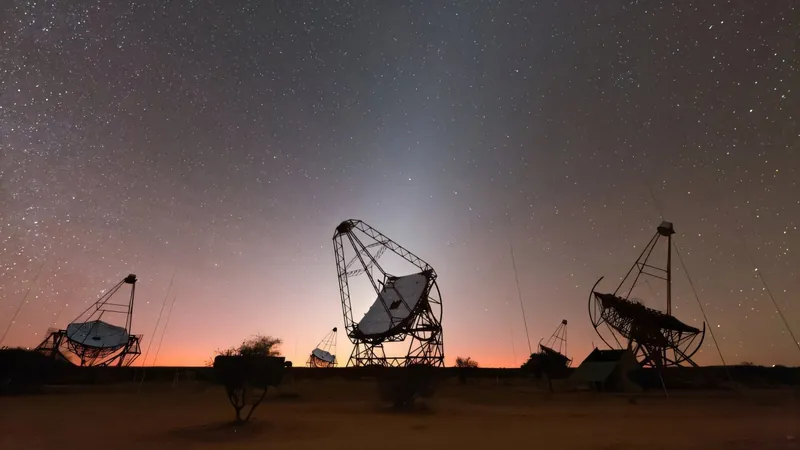
Groundbreaking Discovery: Cosmic Electrons Detected at Record Energies!
2024-11-25
Author: Benjamin
Groundbreaking Discovery
A groundbreaking study led by the H.E.S.S. collaboration in Namibia has unveiled the highest energies of cosmic electrons and positrons ever measured, exceeding a staggering 10 tera-electronvolts. Utilizing a network of five telescopes over the last decade, researchers have made significant strides in our understanding of cosmic radiation, especially gamma radiation, illuminating the mysterious origins of these charged particles.
Challenges in Detecting Cosmic Particles
Detecting the source of cosmic particles has long posed a challenge for scientists, primarily because magnetic fields in our universe deflect these particles, obscuring their paths. However, the exceptional quality of the measurements gathered over the past ten years has opened up thrilling new avenues for exploration. Preliminary findings suggest that the culprits behind these high-energy electrons may be neighboring pulsars, potentially located within just a few thousand light-years from Earth.
The Nature of Cosmic Rays
The universe is home to extreme environments, where colossal energies are released from sources such as supernova remnants, pulsars, and active galactic nuclei. These entities generate charged particles and gamma radiation, dwarfing the energy levels attained through stellar processes like nuclear fusion. Unlike gamma rays, which traverse the cosmos unimpeded, charged particles—or cosmic rays—are altered significantly by the pervasive magnetic forces, arriving at Earth from every conceivable direction. This isotropic arrival complicates efforts to trace their origins.
Energy Loss and Particle Acceleration
One of the intriguing aspects of this study involves the energy lost by charged particles as they interact with light and magnetic fields—a phenomenon particularly pronounced for electrons and positrons with energies above the tera-electronvolt threshold. The presence of extremely high-energy particles detected on Earth indicates they have not traveled vast distances, highlighting the existence of potent natural particle accelerators lurking within our cosmic backyard.
New Insights from H.E.S.S. Analysis
In a remarkable new analysis, the H.E.S.S. team has pinpointed the origins of these cosmic rays with greater precision than ever before. Their investigation into the energy distribution of cosmic electrons reveals a notable "kink" at around one tera-electronvolt, marking a transition point in the spectrum. Above and below this kink, the particle distribution remains consistent, following a power-law trend without additional anomalies.
Understanding the Kink in the Spectrum
What causes this kink? To unravel this mystery, the team compared their findings against theoretical models. Pulsars, which are remnants of massive stars with intense magnetic fields, emerge as key candidates. Some of these pulsars create strong winds of charged particles that could hit shock fronts, accelerating the particles to extraordinary energies. Supernova remnants can provide similar accelerative environments.
Simulations and Tracking Cosmic Particles
Computer simulations that track the journeys of these electrons and positrons through the Milky Way reveal how their energies shift due to interactions with the galaxy’s magnetic fields and light. These simulations are crucial in ensuring the accuracy of particles’ energy spectrum and tracing them back to their origins.
Conclusions and Future Directions
The analysis suggests that while particles below one tera-electronvolt may stem from various pulsars or supernova remnants, those at higher energies offer a sharper concentration of origins. Notably, as energies exceed one tera-electronvolt, we see a marked decline in the particle spectrum—a consistent trend corroborated by theoretical models examining the influence of astronomical sources on particle acceleration.
Statements from Researchers
"The evidence is compelling—we can ascertain that these electrons primarily originate from a limited number of sources within a few thousand light-years of our solar system," explains Kathrin Egberts, a researcher affiliated with the University of Potsdam. This assessment indicates that the cosmic landscape might be less chaotic than previously thought, with identifiable sources responsible for these elusive, high-energy particles.
Significance of the Findings
According to Werner Hofmann from the Max Planck Institute for Nuclear Physics, the concluded findings from this project represent a vital leap in our cosmic understanding, establishing a benchmark for future research.
Publication and Future Prospects
The pivotal paper detailing these findings appears in the prestigious journal *Physical Review Letters*, stirring excitement within the astrophysics community and beyond. As scientists continue to decode the secrets of the universe, this landmark study holds promise for illuminating not only the nature of cosmic rays but also the activities of their originating celestial bodies. Could we finally be on the brink of understanding the enigmatic sources of cosmic radiation? Stay tuned for more discoveries on this cosmic frontier!









 Brasil (PT)
Brasil (PT)
 Canada (EN)
Canada (EN)
 Chile (ES)
Chile (ES)
 España (ES)
España (ES)
 France (FR)
France (FR)
 Hong Kong (EN)
Hong Kong (EN)
 Italia (IT)
Italia (IT)
 日本 (JA)
日本 (JA)
 Magyarország (HU)
Magyarország (HU)
 Norge (NO)
Norge (NO)
 Polska (PL)
Polska (PL)
 Schweiz (DE)
Schweiz (DE)
 Singapore (EN)
Singapore (EN)
 Sverige (SV)
Sverige (SV)
 Suomi (FI)
Suomi (FI)
 Türkiye (TR)
Türkiye (TR)